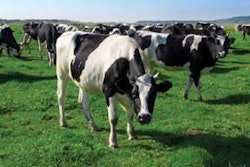
In an environment of high-cost corn, many feed producers are choosing to substitute corn with other crops that have less nutritive value, such as wheat, triticale, sorghum (low-tannin varieties) or barley. However, these cereals are rich in non-starch polysaccharides, and there is a negative correlation between the diet content in non-starch polysaccharides and its nutritive value.
Enzymatic supplementation can improve the nutritive value of cereals containing high levels of soluble non-starch polysaccharides. Several studies have shown that enzymatic supplementation in barley, wheat, triticale or sorghum-based diets can enhance the animal’s performance to a level compared with that obtained in corn-based diets.
Commercially, these supplements are characterized by being a cocktail with different enzymes with different specificities. However, different cereals are rich in different and specific non-starch polysaccharides. So why use an enzymatic cocktail instead of a specific enzyme for a specific diet?
Non-starch polysaccharides
Non-starch polysaccharides are a large variety of polysaccharide molecules, comprising some of the most representative compounds of the cell wall. They can be insoluble or soluble in water.
Insoluble non-starch polysaccharides are indigestible, and in normal amounts, they maintain the normal motility of the gut. Soluble non-starch polysaccharides are more susceptible to biological hydrolysis, especially in the last compartments of the birds’ gastrointestinal tract, such as the caecum. Soluble non-starch polysaccharides display an anti-nutritive effect for poultry due to the resulting increase in digesta viscosity.
An increase in digesta viscosity causes a reduction in digesta passage rate and reduces feed intake and digestibility. It also causes a modification in gut physiology that results in an enlargement of the GI tract. The lower passage rate also results in the proliferation of a fermentative anaerobic microflora in the upper compartments of the GI tract.
Digestion
The normal and healthy microflora is composed of facultative anaerobic microorganisms in jejunum and strict anaerobic microorganisms in caecum. The decrease in digestibility is due to an increase in size and stability of digesta layers without motility in mucosa surface leading to a minor contact between feed and enzymes, which leads to a decrease in nutrient availability.
These consequences are more frequent when the carbohydrate degree of polymerization is higher. The digestion of non-starch polysaccharides depends on the animal (presence of microflora able to digest non-starch polysaccharides increases with animal age), the solubility of non-starch polysaccharides, chemical structure of polysaccharide (linkage between sugars determines the fermentation extension of the different carbohydrates) and the amount of non-starch polysaccharides in the diet (anti-nutritive effects of non-starch polysaccharides are related to the concentration of them in the diet).
Enzyme supplementation
As described above, there is a negative correlation between the diet content in non-starch polysaccharides and its nutritive value. To overcome this problem, enzyme supplementation in diets based on cereals rich in non-starch polysaccharides is widely used. The addition of enzymes to monogastric animal diets reduces the degree of polymerization of non-starch polysaccharides, which then have a lower capacity to affect digesta viscosity.
Enzymes need only to cleave the carbohydrate at a few places in the polysaccharide chain to greatly reduce the viscosity of solutions and thus enhance nutritive value. This supplementation improves nutrient digestibility and feed intake, increasing the animal’s performance. The polysaccharide disruption not only reduces the viscosity but also releases nutrients and thus increases the feed metabolizable energy.
Barley and oats are rich in β-glucans, which are responsible for the low nutritive value of the diets based on these raw materials. Feed supplementation with β-glucanases decrease the polymerization degree of β-glucans, allowing a better use of the nutrients released, and leading to an increase in feed intake and to a decrease in the feed conversion ratio. Arabinoxylans are the major contributors to soluble non-starch polysaccharides released from wheat, rye and triticale. In the same way, also xylanases can depolymerize this substrate and improve its nutritive value.
Advantages of single specific enzymes
Several studies have shown equal or better results in broilers’ performance when a single specific enzyme is used compared with a commercial mixture. This suggests that it is possible to use just one enzyme, which could save feed producers money in enzyme supplementation. Besides the supplementation with enzymes, it is also important to evaluate the need of the supplementation. It has been shown that endogenous enzymatic activity is encountered in some crops, such as barley.
Additionally, some study results have shown that exogenous supplementation is redundant when some barley varieties are used. This redundancy was explained by a high endogenous enzymatic activity in barley crops that was shown to be satisfactory for the improvement of nutritive value of this cereal. This was evaluated by the decrease in digesta viscosity and improvement in the animal’s performance.
Justifying enzymatic supplementation
It seems that it is very important to evaluate the endogenous activity of the grains to justify the use of enzymatic supplementation. It is also known that different cereal grains have different non-starch polysaccharides content. From low to higher contents: rice, sorghum, corn, wheat, triticale, rye and barley.
Non-starch polysaccharides content also seems to be dependent on some other factors, such as crop variety and environmental growth conditions. Different varieties of the same cereal may have different non-starch polysaccharides content and consequently have a different impact on animals’ performance. Using specific enzymes in poultry nutrition makes it possible to use cereals with lower nutritive value. Cereals with lower nutritive value usually have lower prices, which may be an opportunity for feed producers.
Enzyme engineering can be part of a solution to the feeding problem in poultry. Enzyme engineering based on most efficient microorganisms, together with the use of recombinant genetic manipulation, can improve enzyme efficiency and consequently can help increase the widespread use of cereals as a corn alternative.














